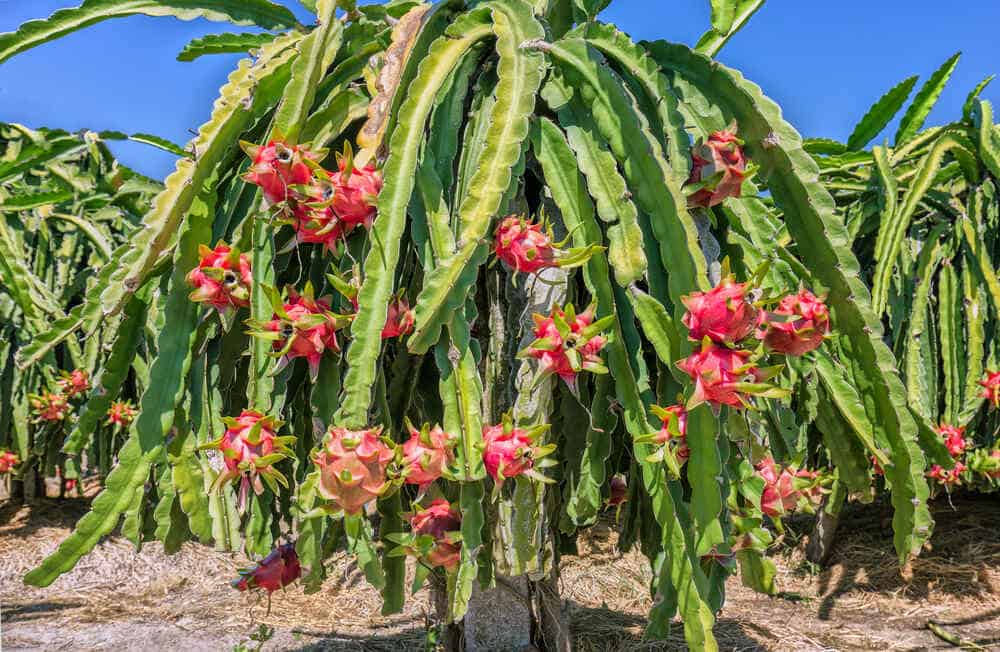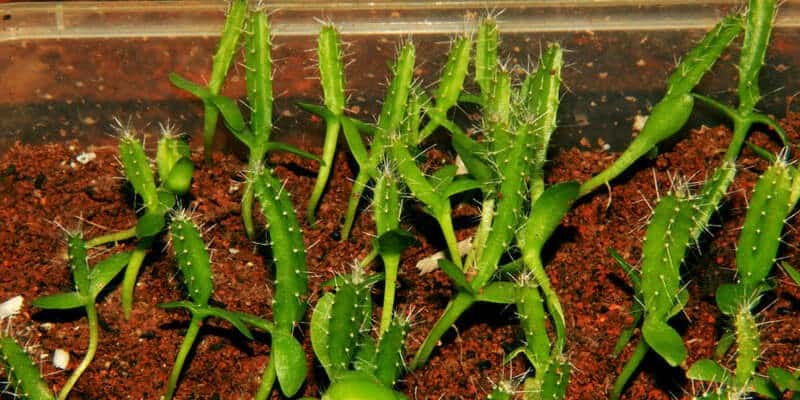What’s round, spiky, and pink all over? Dragon fruit is a funky little plant — did you know that it’s actually a succulent?
The brightly-coloured fruit goes by many names: dragon fruit, pitaya, pitahaya, strawberry pear, Night blooming cereus, Belle of the night, and even cactus fruit.
The most popular variety is hylocereus undatus, easily recognisable by its vivid pink skin with green spines. When you cut the fruit in half, the inner white flesh is speckled with tiny black seeds.
The dragon fruit cactus is originally native to Mexico and South America, but has long since spread across the globe.
You can put dragon fruit slices in salads or smoothies, or simply eat the chilled fruit on a hot day.
And while you could run out to the shops to get this tropical fruit as a treat, you can also grow dragon fruit right in your garden!
How? Here’s a guide for growing dragon fruit so you can enjoy them when they’re in season.
About Dragon Fruits
It seems unbelievable, but the dragon fruit plant is actually related to the orchid cacti (epiphyllum).
While the orchid cactus is known for its large, vivid red or pink flowers, though, dragon fruit plants are known for their large, vivid red or pink… well, fruits.
(Note: the texture and taste may be similar, but dragon fruits are not actually related to kiwi fruits!)
For the dragon fruit plant itself, it is a climbing cactus vine that grows fairly long, with the flower (and eventually, fruit) appearing at the end of the leaf.
This tropical fruit prefers warm, humid climates like its native South America (making it perfect for Australia).
The ‘dragon’ part of its name refers to its bright, leathery skin and green-tipped spikes.
Don’t let it deter you, though — the white flesh of the fruit is mildly sweet and soft, with crunchy black seeds.
The texture resembles kiwi fruit, which is probably why people relate the two. Dragon fruit is rich in vitamin C and carotene, making it a healthy treat.
The dragon fruit flower is large and white, and blooms for only one night — then withers by morning. Count yourself lucky if you catch it!
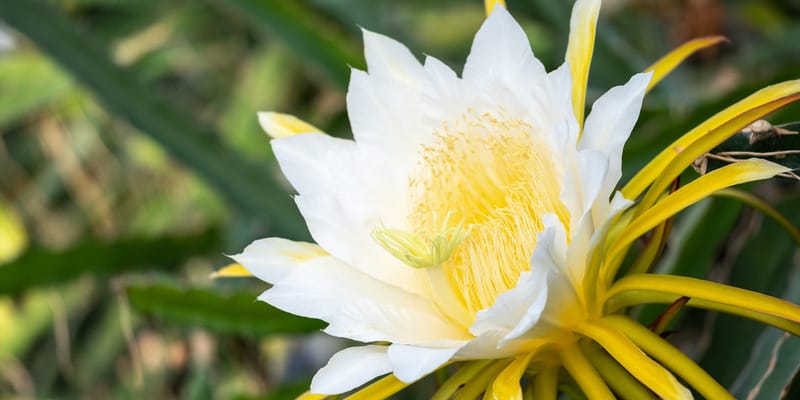
Dragon Fruit Plant Types
“Dragon fruit” is a name that refers to several species of cacti that produce edible fruit.
In Australia, this commonly includes:
- Hylocereus undatus (the classic pink dragon fruit)
- Hylocereus costaricensis (a red skin dragon fruit)
- Hylocereus megalanthus (a yellow skin dragon fruit)
There are other varieties available for growing dragon fruit plants, but these are the most common
Fortunately, they all have the same basic growing conditions.
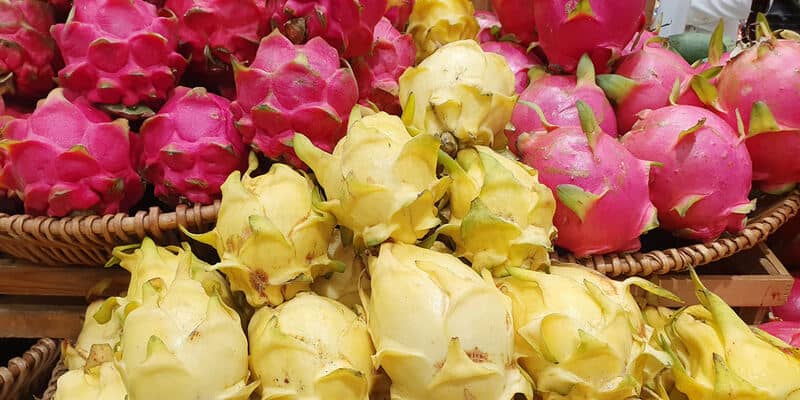
Where To Grow A Dragon Fruit Plant
It may be a cactus, but it doesn’t thrive in a desert — a dragon fruit plant needs tropical or subtropical climates, with warm, humid environments.
Optimal growth temperatures are between 18–32ºC. If your region is prone to cold winters, frost, or extreme heat, you can also grow dragon fruit plants in a pot!
Growing Dragon Fruit Plants
If you’re planning on growing dragon fruit plants in your garden, you need to be mindful of the conditions in which you grow them.
Check in with a professional gardening service if you need help, especially when it comes to soil prep and plant support!
Support system
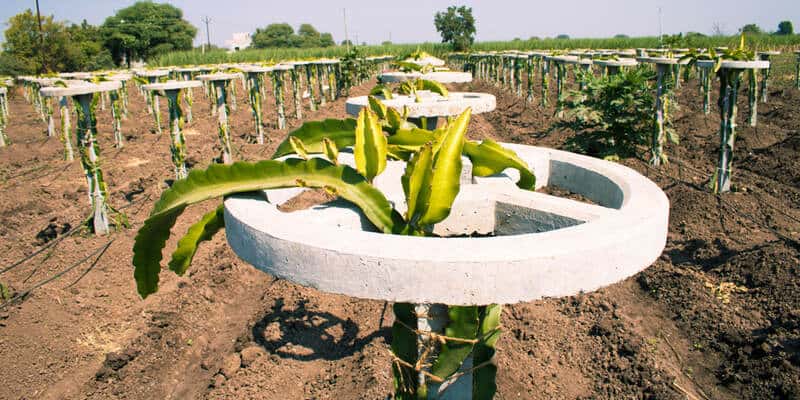
Since this is a climbing cactus, dragon fruit needs some help to keep it upright. Once the plant reaches 30cm tall, it’ll need a stake or similar support system so it can continue growing.
You can also position the plant by a trellis so it can climb up the post — functional and aesthetic!
Soil
Like many fruit-bearing plants, dragon fruit grows best in well drained soil. It should also be slightly acidic, with a pH level between 6 and 7. Choose sandy soil if available, but any free-draining soil will work if not.
It might be tempting, but don’t use cactus potting soil! Dragon fruit prefers soil that retains moisture more than other cacti.
Water
Don’t overwater your dragon fruit plant — only water it when the top layer of soil is dry to touch.
And don’t soak! That might end up rotting the roots. Water only enough that the soil is moist, not soaked.
Light

A dragon fruit tree needs at least six hours of sunlight a day to grow. Ideally, plant it somewhere with full sun so that the dragon fruit grows properly.
The base can tolerate some shade, but the tips — where flowers and fruits grow — need sun to develop. If there’s too much shade, it might struggle to produce fruit.
Fertiliser
A dragon fruit plant will have plenty of nutrients in its natural environment, so it’ll need a boost to thrive in your garden. During dragon fruit growing season, feed it every month with an organic fertiliser.
You can also mulch the soil around it with organic material such as compost, manure, or seaweed. Just don’t layer too close to the base or you might smother the roots!
Pruning

You can keep your plant under control by pruning it during the summer months.
Cut back any dead or diseased branches to prevent them from damaging the rest of your plant. You should also remove some branches where they’re crowding together to promote growth.
It’s most important to watch your dragon fruit plant for signs of rot, given the more extreme weather conditions. Prune away any branches that show rot to prevent it from spreading — and fast!
How To Grow Dragon Fruit
If your climate allows it, you can grow dragon fruit in your garden. Otherwise, it’s straightforward enough to plant it in a pot!
Growing dragon fruit in a garden
From seed
You can grow dragon fruit from seed, but be ready to be very patient! First, take a dragon fruit, either from a grocery or a local nursery. Scoop out the seeds, then rinse them to get rid of any pulp.
Lay the seeds overnight on a moist paper towel, or for at least twelve hours. After that, take them and sprinkle them across the soil surface.
Cover with a thin layer of earth — dragon fruit seeds don’t need to be planted deep.
Water or mist the soil to keep it moist but not soaked, but only when it’s dried out. You can mulch the soil to help retain moisture while your seeds are germinating.
As a dragon fruit plant starts growing, thin out the branches to give it room. Give it a stake once it reaches 30cm so it doesn’t slump. Once the plant is established, slow down its watering schedule.
Don’t expect the plant to produce fruit right away — it’ll take 5–7 years for your dragon fruit to mature. You’ll get fruit much faster if you grow from cuttings!
From cuttings
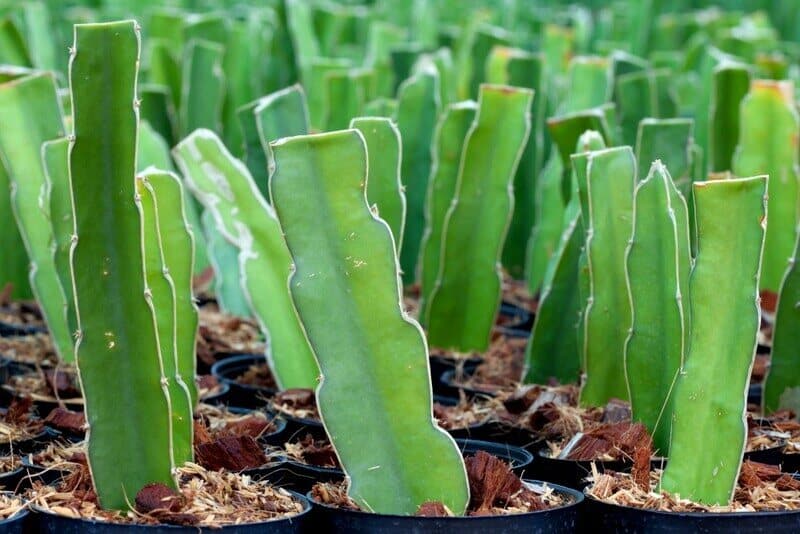
Propagating dragon fruit from cuttings is straightforward — just take a 30cm second of a mature dragon fruit tree.
You can cut this up further into 3–5 pieces, or leave it as-is. Just keep track of which way is “up”!
Cure your cuttings by leaving them in a warm, dry area. Once the edges turn white, they’re ready to plant — it’ll take about three days to a week.
Plant each cutting about 2–5cm into the soil, then firm up the ground around it so it stays upright. Make sure you’ve planted it the right way up!
Water when the soil dries out, then wait for the cuttings to develop a root system in about 3–4 weeks.
Again, give each plant a support when it reaches 30cm tall! It’ll take about 2–3 years for your plant to mature, but that’s still sooner than from seed, at least.
Growing dragon fruit in a pot
The process for planting dragon fruit in a pot is similar to that in a garden, whether it’s from seeds or cuttings.
The important thing to remember is the plant needs repotting as it gets bigger.
A mature dragon plant needs a container at least 60cm wide and 25cm deep for it to thrive — and put it somewhere sunny!
Choose potting soil that drains well — preferably a sandy mix. Don’t use cactus potting soil, since it won’t retain water as much as your plants might like!
And yes, they’ll still need a stake even indoors — the last thing you want is a slumping cactus plant. It doesn’t look pretty.
Dragon Fruit Season
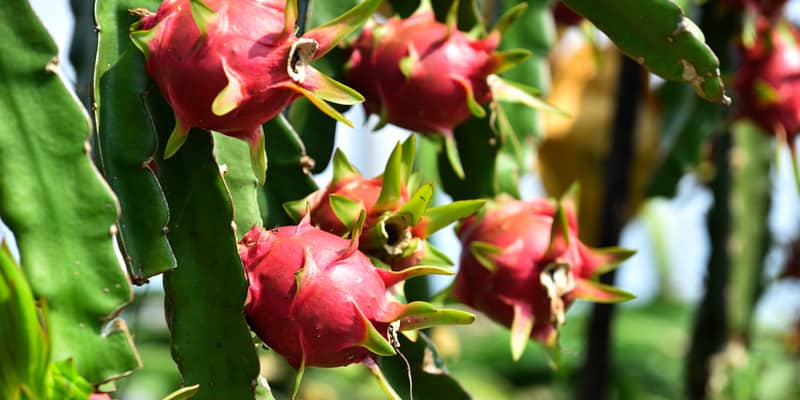
Dragon fruit season in Australia comes in the early summer, and can continue into autumn. Start anticipating fruit after the plant flowers. Once it starts producing fruit, it’ll take about 4 weeks to ripen.
You can tell a dragon fruit is ripe because the skin is a vivid pink (or red or yellow, depending on the variety you planted).
The tips will also have started to wither. Twist the fruit carefully — if it comes off the stem, it’s ready. Don’t wait until the fruit falls or it’ll be overripe.
You can also cut off just-ripe pitaya from the tree and keep it in the fridge for up to two weeks. It won’t ripen after picking, so don’t cut it off too early!
FYI: A dragon fruit plant can produce fruits for decades, so be ready for plenty. But like the dragon it’s named after, we won’t blame you for hoarding — it’s just that good!

